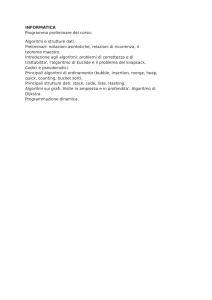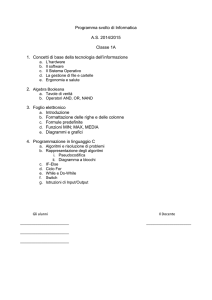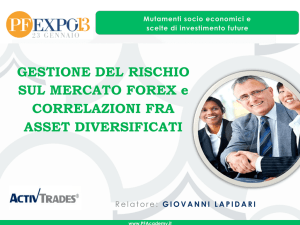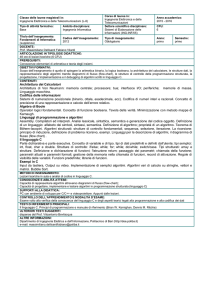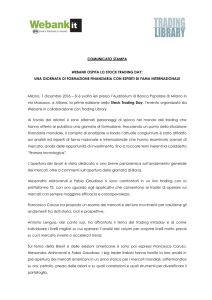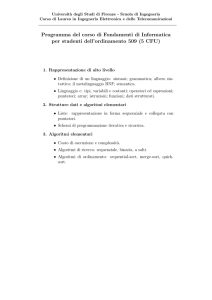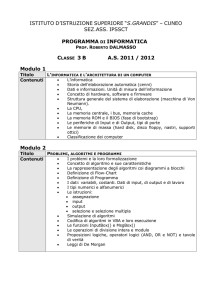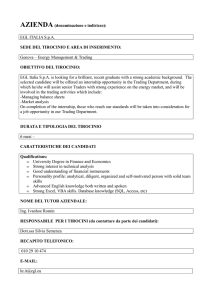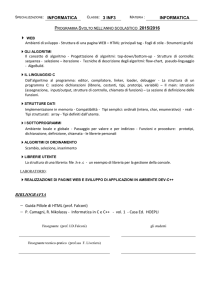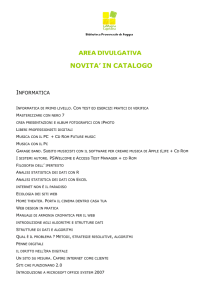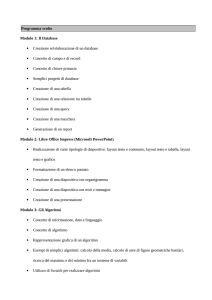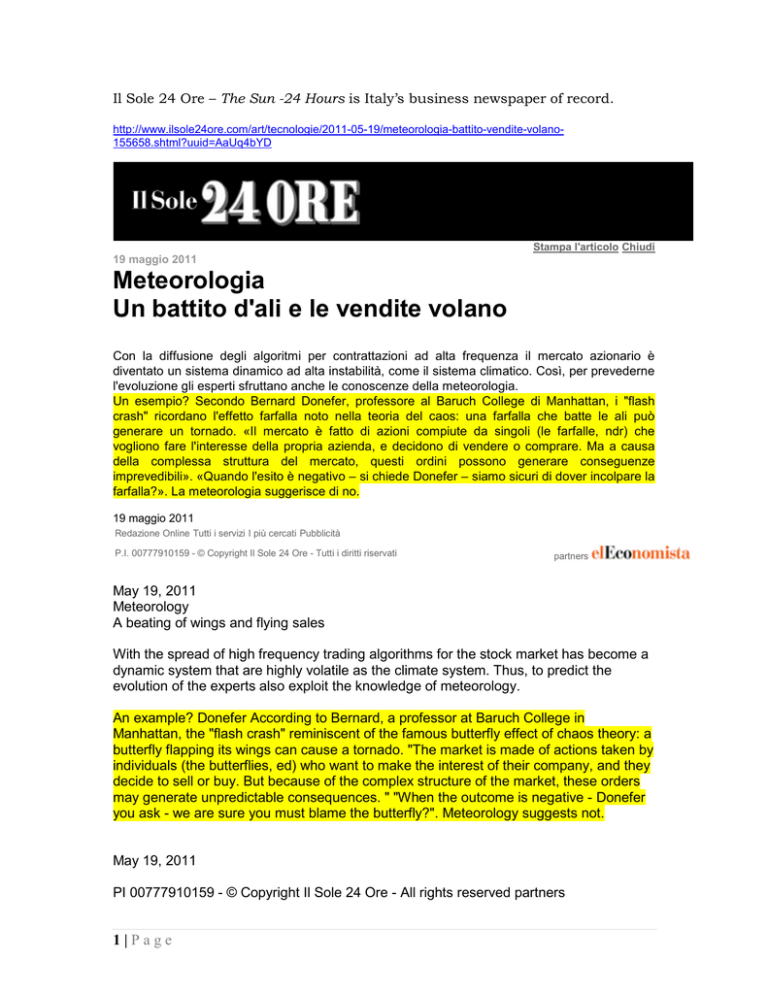
Il Sole 24 Ore – The Sun -24 Hours is Italy’s business newspaper of record.
http://www.ilsole24ore.com/art/tecnologie/2011-05-19/meteorologia-battito-vendite-volano155658.shtml?uuid=AaUq4bYD
Stampa l'articolo Chiudi
19 maggio 2011
Meteorologia
Un battito d'ali e le vendite volano
Con la diffusione degli algoritmi per contrattazioni ad alta frequenza il mercato azionario è
diventato un sistema dinamico ad alta instabilità, come il sistema climatico. Così, per prevederne
l'evoluzione gli esperti sfruttano anche le conoscenze della meteorologia.
Un esempio? Secondo Bernard Donefer, professore al Baruch College di Manhattan, i "flash
crash" ricordano l'effetto farfalla noto nella teoria del caos: una farfalla che batte le ali può
generare un tornado. «Il mercato è fatto di azioni compiute da singoli (le farfalle, ndr) che
vogliono fare l'interesse della propria azienda, e decidono di vendere o comprare. Ma a causa
della complessa struttura del mercato, questi ordini possono generare conseguenze
imprevedibili». «Quando l'esito è negativo – si chiede Donefer – siamo sicuri di dover incolpare la
farfalla?». La meteorologia suggerisce di no.
19 maggio 2011
Redazione Online Tutti i servizi I più cercati Pubblicità
P.I. 00777910159 - © Copyright Il Sole 24 Ore - Tutti i diritti riservati
partners
May 19, 2011
Meteorology
A beating of wings and flying sales
With the spread of high frequency trading algorithms for the stock market has become a
dynamic system that are highly volatile as the climate system. Thus, to predict the
evolution of the experts also exploit the knowledge of meteorology.
An example? Donefer According to Bernard, a professor at Baruch College in
Manhattan, the "flash crash" reminiscent of the famous butterfly effect of chaos theory: a
butterfly flapping its wings can cause a tornado. "The market is made of actions taken by
individuals (the butterflies, ed) who want to make the interest of their company, and they
decide to sell or buy. But because of the complex structure of the market, these orders
may generate unpredictable consequences. " "When the outcome is negative - Donefer
you ask - we are sure you must blame the butterfly?". Meteorology suggests not.
May 19, 2011
PI 00777910159 - © Copyright Il Sole 24 Ore - All rights reserved partners
1|Page
Stampa l'articolo Chiudi
NELLA BOTTEGA DEI GUADAGNI AL MILLISECONDO
ANTONIO LARIZZA
Gli algoritmi che, a intervalli di millisecondi, senza sosta, regolano miliardi di operazioni
finanziarie in tutto il mondo, cambiano natura ogni giorno. Come organismi, evolvono o
periscono. Come membri di una comunità nata per generare profitto – dove l'egoismo
offusca la legge, talvolta non solo quella morale – si confrontano seguendo gli istinti di
sopravvivenza e sopraffazione. I programmatori che li progettano si rincorrono sensa
sosta, incarnando la massima latina dell'homo homini lupus. Per farlo, prendono in
prestito armi appuntite: gli insegnamenti di scienze solo apparentemente lontane. Per
programmare algoritmi per il trading ad alta frequenza nascono così team
interdisciplinari fatti di matematici, fisici, economisti, scienziati sociali, biologi. Che
applicano agli indici di Borsa conoscenze di balistica e meteorologia; ma anche
sofisticati strumenti di analisi semantiche, modelli di studi comportamentali, matrici
biologiche e teorie evoluzionistiche. Il vecchio trader, in ufficio, non c'è più: il software
l'ha mandato in pensione; oppure gli permette di andare a giocare a tennis, dopo avergli
chiesto poche e sintetiche istruzioni, sufficienti per operare in modo automatico sui
mercati. Con quali risultati? Sul lungo periodo non c'è molta differenza nei guadagni. La
vera differenza sta nel fatto che l'algoritmo ha prestazioni più regolari: l'uomo perde
molto o guadagna molto. Il software, privo di emotività, è invece più sistematico. Certo,
aumentando le operazioni, cresce la complessità e il mercato è più instabile, come
dimostrano le decine di centinaia di flash crash che avvengono ogni anno sui mercati,
puntualmente monitorati dalla società di analisi finanziaria Nanex (www.nanex.net).
In questa caotica guerra al millisecondo è possibile individuare alcuni tratti dominanti. Le
strategie di trading ad alta frequenza sono caratterizzate da un corto portfolio holding
period, tipicamente da meno di un secondo a un giorno. Le strategie fanno un gran
numero di transazioni e ordini con un piccolo guadagno per transazione. Inoltre sono di
solito market neutral, cioè la loro performance non è influenzata dal movimento
complessivo del mercato. Di solito ma non sempre, come hanno imparato bene i
mercati. Durante gli interminabili millisecondi dei peggiori flash crash.
[email protected]
[email protected]
© RIPRODUZIONE RISERVATA
Un battito d'ali e le vendite volano Con la diffusione degli algoritmi per contrattazioni ad
alta frequenza il mercato azionario è diventato un sistema dinamico ad alta instabilità,
come il sistema climatico. Così, per prevederne l'evoluzione gli esperti sfruttano anche le
conoscenze della meteorologia. Un esempio? Secondo Bernard Donefer, professore al
Baruch College di Manhattan, i "flash crash" ricordano l'effetto farfalla noto nella teoria
del caos: una farfalla che batte le ali può generare un tornado. «Il mercato è fatto di
azioni compiute da singoli (le farfalle, ndr) che vogliono fare l'interesse della propria
azienda, e decidono di vendere o comprare. Ma a causa della complessa struttura del
mercato, questi ordini possono generare conseguenze imprevedibili». «Quando l'esito è
negativo – si chiede Donefer – siamo sicuri di dover incolpare la farfalla?». La
meteorologia suggerisce di no. METEOROLOGIA L'algoritmo è genetico Il
comportamento del mercato finanziario può essere analizzato anche con le leggi
dell'evoluzione. Per questo motivo i software più evoluti per il trading ad alta frequenza
2|Page
sfruttano una particolare famiglia di algoritmi: gli algoritmi genetici. Si tratta di una classe
molto promettente di algoritmi, molto utilizzati anche nel campo dell'intelligenza
artificiale. Eseguono calcoli a partire da una base di conoscenze, applicando un metodo
euristico di ricerca e ottimizzazione dei dati. Per farlo si ispirano al principio della
selezione naturale che regola l'evoluzione biologica, elaborato da Charles Darwin. In
finanza gli algoritmi genetici vengono usati nell'analisi dell'andamento (evoluzione) degli
scambi e delle transazioni. Ma anche per individuare eventuali tendenze
comportamentali degli attori coinvolti, con lo scopo di interpretarle correttamente.
EVOLUZIONE BIOLOGICA Ordini civetta (per chi abbocca) Dinamiche di finanza
comportamentale e psicologia delle folle entrano in scena tutti i giorni negli scambi dei
mercati finanziari globali. Dal 2008, in particolare, da quando è esploso su larga scala il
trading algoritmico ad alta velocità, il duello tra le scelte emotive (di conseguenza
irrazionali) dell'uomo e le decisioni automatizzate prese dagli algoritmi finanziari si è
accentuato. Un duello ad armi impari. Come dimostra la tecnica del quote stuffing (ordini
civetta) praticata da svariati algoritmi. Come funziona? Il mercato viene inondato da una
gran numero di ordini limite che vengono cancellati immediatamente. Lo scopo di questi
ordini non è liquidare le posizioni ma spingere gli investitori reali ad acquistare a prezzi
più alti. Quando il prezzo
del titolo finanziario raggiunge il valore prefissato l'algoritmo procede alla vendita dei
titoli lasciando nelle mani di investitori reali poco accorti titoli "gonfiati". SCIENZA
COMPORTAMENTALE
La forzatura artificiale delle quotazioni
ARTIGIANI DELLA FINANZA GLOBALE
BALISTICA
(In)controllabile come un proiettile
Nell'alchimia degli algoritmi che muovono gran parte degli scambi finanziari da un paio
d'anni a questa parte un ruolo chiave, tra le varie discipline scientifiche, lo gioca anche la
balistica, il ramo della fisica meccanica che studio il moto di un proiettile. In che modo?
«I sistemi di trading automatico portano i mercati in uno stato di equilibrio instabile, che
tende a reagire violentemente alle sollecitazioni. Quindi, nel gergo anglosassone si dice
"the market went ballistic" riferendosi al fatto che i prezzi sembrano muoversi senza
particolare relazione agli eventi esterni, ma come se fossero sotto l'effetto di forze
interne, similmente a quanto avviene a un proiettile: una volta lanciato non lo si può più
controllare», spiega Enrico Melchioni di Fmr Consulting, società specializzata in
tecnologie per la finanza quantitativa e nell'elaborazione di algoritmi finanziari.
METEOROLOGIA
Un battito d'ali e le vendite volano
Con la diffusione degli algoritmi per contrattazioni ad alta frequenza il mercato azionario
è diventato un sistema dinamico ad alta instabilità, come il sistema climatico. Così, per
prevederne l'evoluzione gli esperti sfruttano anche le conoscenze della meteorologia. Un
esempio? Secondo Bernard Donefer, professore al Baruch College di Manhattan, i "flash
crash" ricordano l'effetto farfalla noto nella teoria del caos: una farfalla che batte le ali
può generare un tornado. «Il mercato è fatto di azioni compiute da singoli (le farfalle,
3|Page
ndr) che vogliono fare l'interesse della propria azienda, e decidono di vendere o
comprare. Ma a causa della complessa struttura del mercato, questi ordini possono
generare conseguenze imprevedibili». «Quando l'esito è negativo – si chiede Donefer –
siamo sicuri di dover incolpare la farfalla?». La meteorologia suggerisce di no.
SEMANTICA
Alla ricerca di informazioni
Parole, parole, parole. Tra le scienze a cui attingono i matematici impegnati nella
costante formulazione di nuovi algoritmi finanziari c'è anche la semantica. Una delle
strategie alla base del trading automatizzato è, infatti, conosciuta come event trading. Gli
algoritmi, in questo caso, monitorano le sorgenti di informazione (media, newsfeeds,
blogs eccetera) alla ricerca di notizie sui beni finanziari cercando di interpretarle
computazionalmente il più rapidamente possibile applicando regole di analisi semantica,
natural language processing e data mining. Sulla base di queste interpretazioni gli
algoritmi poi effettuano operazioni di trading prima che il mercato incorpori le
informazioni nel prezzo del titolo finanziario.
In termini di tempo, l'algoritmo
offre un vantaggio competitivo rispetto agli altri operatori di circa un'ora: tale è infatti la
durata del cosiddetto holding period.
Finanza interdisciplinare. L'algoritmo della finanza globale è un concentrato
multidisciplinare: sfrutta la ricerca scientifica condotta nei campi delle scienze fisiche,
matematiche, sociali, biologiche. In queste pagine descriviamo come nascono le
principali strategie di calcolo: formule alla base del meccanismo che regola gli ordini di
acquisto e vendita condotti su larga scala e ad altissima frequenza. L'algoritmo mette un
ordine di vendita di 1.100 azioni al prezzo di 11. L'ordine viene agevolmente eseguito
perché uguale al prezzo di mercato. Nel corso dell'ultimo minuto l'algoritmo ha
acquistato 100 azioni (10 per tranche) attraendo nel mercato compratori reali allettati dai
prezzi crescenti verso l'obiettivo di vendita prefissato di 11. L'operazione comporta un
guadagno netto perché anziché vendere 1.000 azioni a 10 ne vende 1.100 a 11,
lucrando la differenza. Inoltre, il prezzo medio di carico delle 100 azioni acquistate al fine
di far lievitare i prezzi è minore del prezzo di vendita 11: un ulteriore margine di
guadagno.
Proposta di prezzo in vendita
Proposta di prezzo in acquisto
Ecco una delle stategie più utilizzate dagli algoritmi di trading automatico: il software
spinge in alto le quotazioni di un titolo, con l'obiettivo di rivendere a un prezzo più alto.
Prezzo a cui l'algoritmo compra
Redazione Online Tutti i servizi I più cercati Pubblicità
P.I. 00777910159 - © Copyright Il Sole 24 Ore - Tutti i diritti riservati partners
4|Page
SHOP IN SAVINGS TO MILLISECOND
Antonio Larizza
The algorithms that, at intervals of milliseconds, without pause, control billions of
financial transactions worldwide, changing nature every day. As organisms evolve or
perish. As members of a community created to generate profit - where selfishness
obscures the law, sometimes not only moral - are compared according to the instincts for
survival and domination. The programmers who design them stop chasing sensations,
embodying the Latin maxim homo homini lupus. To do this, borrow edged weapons: the
teaching of science seemingly distant. To program the trading algorithms for high
frequency as interdisciplinary teams are born made to mathematicians, physicists,
economists, social scientists, biologists. They apply to stock indexes knowledge of
ballistics and meteorology, but also sophisticated tools for semantic analysis, models of
behavioral studies, biological matrices and evolutionary theories. The old trader, in the
office, there's more: the software has sent him into retirement, or allows him to go play
tennis, after asking him a few summary statements, sufficient to operate automatically in
the markets. With what results? In the long run there is not much difference in earnings.
The real difference lies in the fact that the algorithm performs more regular: the man
loses or gains very much. The software, free of emotion, it is more systematic. Of
course, increasing transactions, the complexity grows and the market is more volatile, as
demonstrated by the tens of hundreds of flash crashes that occur each year in the
markets, regularly monitored by the independent financial analysis Nanex
(www.nanex.net).
In this chaotic war to the millisecond is possible to identify some dominant traits. The
high-frequency trading strategies are characterized by a short portfolio holding period,
typically less than a second to a day. The strategies are a large number of transactions
and orders with a small profit per transaction. They are also generally market neutral, ie,
their performance is not affected by movement in the market. Usually but not always, as
they have learned well the markets. During the interminable ms flash of the worst crash.
antonio.larizza @ ilsole24ore.com
vito.lops @ ilsole24ore.com
© REPRODUCTION RESERVED
A beating of wings and fly with sales spread of high frequency trading algorithms for the
stock market has become a dynamic system that are highly volatile as the climate
system. Thus, to predict the evolution of the experts also exploit the knowledge of
meteorology. An example? Donefer According to Bernard, a professor at Baruch College
in Manhattan, the "flash crash" reminiscent of the famous butterfly effect of chaos theory:
a butterfly flapping its wings can cause a tornado. "The market is made of actions taken
by individuals (the butterflies, ed) who want to make the interest of their company, and
they decide to sell or buy. But because of the complex structure of the market, these
orders may generate unpredictable consequences. " "When the outcome is negative Donefer you ask - we are sure you must blame the butterfly?". Meteorology suggests
not. METEOROLOGY The genetic algorithm is the behavior of financial markets can
also be analyzed with the laws of evolution. For this reason, the most advanced software
for high-frequency trading exploiting a particular family of algorithms: genetic algorithms.
This is a very promising class of algorithms, widely used in the field of artificial
intelligence. Perform calculations from a knowledge base, applying a heuristic search
and optimization of the data. To do embody the principle of natural selection that
governs biological evolution, developed by Charles Darwin. In finance, genetic
5|Page
algorithms are used in the analysis (evolution) of trade and transactions. But also to
identify any behavioral tendencies of the actors involved, in order to interpret them
correctly. BIOLOGICAL EVOLUTION Orders owl (for those who bait) Dynamics of
behavioral finance and psychology of crowds come on the scene every day in trade of
global financial markets. Since 2008, in particular, has exploded since large-scale highspeed algorithmic trading, the duel between the emotional choices (and therefore
irrational) human and automated decisions taken by financial algorithms has increased.
A duel with unequal weapons. As demonstrated by the technique of stuffing units (orders
owl) practiced by various algorithms. How does it work? The market is flooded with a
large number of limit orders that are canceled immediately. The purpose of these orders
is not liquidate positions, but the real push investors to buy at higher prices. When the
price
Title Financial reaches the set, the algorithm proceeds to the sale of securities in the
hands of investors leaving real soon realized securities "inflated". BEHAVIORAL
SCIENCE
Forcing artificial prices
ARTISANS OF GLOBAL FINANCE
BALLISTIC
(In) controllable like a bullet
In alchemy the algorithms that drive much of the financial exchange for a couple of years
now a key role among the various scientific disciplines, it also plays ballistics, the branch
of physics that studies the mechanical motion of a projectile. In what way? "The
automated trading systems lead the market in a state of unstable equilibrium, which
tends to react violently to stress. Then, in the Anglo-Saxon parlance is called "The
Market Went ballistic" referring to the fact that prices seem to move without much regard
to external events, but as if they were under the influence of internal forces, similar to
what happens to a bullet, once it can not be launched more control, "says Henry
Melchioni Fmr Consulting, a company specializing in technologies for quantitative
finance and the development of financial algorithms.
METEOROLOGY
A beating of wings and flying sales
With the spread of high frequency trading algorithms for the stock market has become a
dynamic system that are highly volatile as the climate system. Thus, to predict the
evolution of the experts also exploit the knowledge of meteorology. An example?
Donefer According to Bernard, a professor at Baruch College in Manhattan, the "flash
crash" reminiscent of the famous butterfly effect of chaos theory: a butterfly flapping its
wings can cause a tornado. "The market is made of actions taken by individuals (the
butterflies, ed) who want to make the interest of their company, and they decide to sell or
buy. But because of the complex structure of the market, these orders may generate
unpredictable consequences. " "When the outcome is negative - Donefer you ask - we
are sure you must blame the butterfly?". Meteorology suggests not.
SEMANTICS
6|Page
Looking for information
Words, words, words. Among the sciences that draw from the mathematicians involved
in the constant development of new financial algorithms, there is also the semantics.
One of the strategies behind the automated trading is, in fact, known as event trading.
The algorithms in this case, the monitor information sources (media, newsfeeds, blogs,
etc.) to get the news on the financial assets trying to interpret computationally as quickly
as possible by applying rules of semantic analysis, natural language processing and
data mining. Based on these interpretations algorithms then make trades before the
market incorporates the information in the price of financial stocks.
In terms of time, the algorithm
provides a competitive advantage over other operators about an hour: this is indeed the
duration of the so-called holding period.
Finance disciplines. The algorithm of global finance is a concentrated multi-disciplinary
uses the scientific research conducted in the fields of physical sciences, mathematics,
social, biological. These pages describe the main strategies are born as calculated from
the formulas underlying the mechanism that regulates the purchase orders and sales
conducted on a large scale and high frequency. The algorithm places a sell order for
1,100 shares at a price of 11. The order is easily done because it equals the market
price. During the last minute, the algorithm has purchased 100 shares (10 per tranche)
in the market attracting real buyers attracted by rising prices to the sales target set of 11.
This results in a net gain rather than to sell because it sells 1,000 shares at 10 to 11
1100, benefit from a difference. In addition, the average price drop of the 100 shares
purchased in order to raise the price of the sale price is less than 11: an additional
margin.
Proposed sale price
Proposed purchase price
This is one of a strategic trading algorithms used by most automatic software pushes up
the prices of a security, in order to resell at a higher price.
Price at which the algorithm Buy
Online Editor All services The most searched Advertising
PI 00777910159 - © Copyright Il Sole 24 Ore - All rights reserved partners
7|Page

